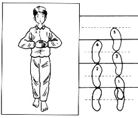Introduction to Practice
Etiquette
Dress: Please dress comfortably in subdued colors and in a way suited to visiting a spiritual place. Do not wear shoes in the meditation hall. Socks are okay.
Please arrive a few minutes early and be seated before beginning time.
Do not bring food, drink, or electronic devices into the meditation hall.
Please face the altar and bow in gassho upon entering the temple and again upon leaving. Move about quietly and silently.
Gassho Hold the palms and fingers of both hands together. 
Gassho is an expression of acknowledgment and courtesy. In this gesture, the two hands, representing duality, are joined together in oneness.
The Practice of Zazen (sitting meditation)
You may select either a chair or a zafu (cushion) on which to sit. At your seat, bow in gassho towards the zafu and then turn clockwise and bow in gassho towards the opposite side of the hall.
The Bell is Rung
- three times when zazen begins
- twice when kinhin (walking meditation) begins
- once when kinhin is finished
- once when zazen is finished.
Sitting meditation
- Sit on the front part of the chair or cushion.
- Arrange your legs in a position you can maintain comfortably.
- In the full-lotus position, first place your right foot on your left thigh, then your left foot on your right thigh. You may also sit simply with your legs tucked in close to your body, but be sure that your weight is distributed on three points: both of your knees on the ground and your buttocks on the round cushion.

- In the half-lotus position, place your left foot on your right thigh.
- Another option is the seiza position, which is like kneeling, except you are sitting on the front edge of the zafu.

On a chair, keep your knees apart about the width of your shoulders, feet firmly planted on the floor. - Straighten and extend your spine, keeping it naturally upright, centering your balance in the lower abdomen. Push your lower back a little forward, open your chest, and tuck your chin in slightly, keeping the head upright, not leaning forward or backward, or to the side. Sway your body gently from left to right, until you naturally come to a point of stillness on your cushion.
- Keep your eyes slightly open. Cast them downward at about a 45 degree angle. Without focusing on any particular thing, let everything have its place in your field of vision. If your eyes are closed, you will easily drift into drowsiness or daydream.
- Keep your lips and teeth together with your tongue resting against the roof of your mouth.
- Place your hands on your lap with the right palm up and your left hand (palm up) resting on your right hand, thumb tips lightly touching, forming a horizontal oval.

This is the mudra of zazen, in which all things are unified. Place the sides of the little fingers against your abdomen, a few inches below the navel, harmonizing your center of gravity with the mudra. - Take a few deep breaths, exhaling fully. Let your breath settle into its natural rhythm. With proper physical posture, your breathing will flow naturally into your lower abdomen.
- Sitting still, keep your attention on your breath. When your attention wanders, bring it back to the breath again and again- as many times as necessary.
- Be fully, vitally present. Simply do your very best. At the end of your sitting period, gently sway your body from right to left. Stretch out your legs; be sure they have feeling before standing.
Walking Meditation (Kinhin)

Hold your hands in shashu by putting the thumb of your left hand in the middle of the palm and make a fist around it. Place the fist in front of your chest. Cover the fist with your right hand. Keep your elbows away from your body forming a straight line with both forearms.Take half a step for every breath.
You can download this information, Introduction to Practice, as a tri-fold brochure in PDF. Please print double-sided & fold into thirds.

